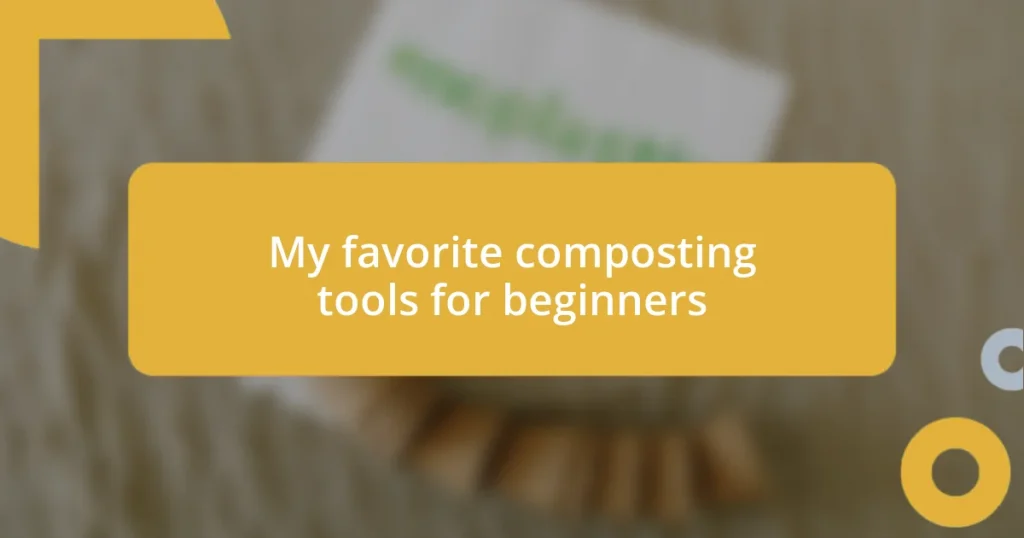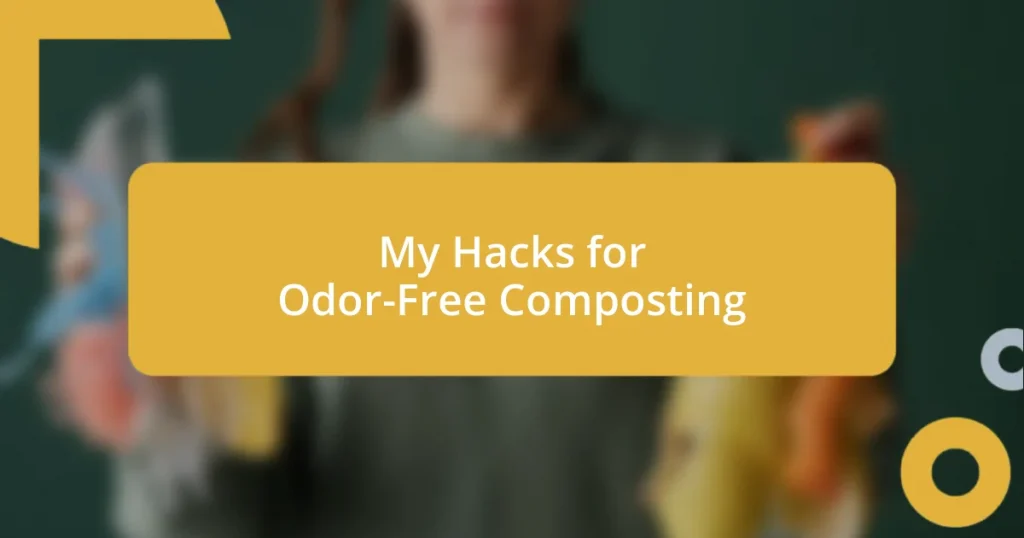Key takeaways:
- Aeration methods such as turning with a pitchfork, using perforated pipes, and employing passive bins enhance compost health by introducing oxygen, which is essential for microbial activity and reducing odors.
- Regularly turning compost, especially at the right intervals and with gentle techniques, prevents compaction and ensures optimal oxygen levels for effective decomposition.
- Additives like aged manure, shredded wood chips, and biochar can significantly improve aeration, nutrient retention, and overall compost structure, enhancing the composting process.

Understanding compost aeration methods
When it comes to compost aeration methods, I’ve found that there are several effective techniques, each with its own advantages. For example, turning the pile with a pitchfork is a classic method that not only mixes the materials but also helps to introduce fresh air. I remember my first attempt; it felt a bit like wrestling with a giant, smelly monster, but the satisfaction I felt when the compost heated up was worth the effort!
Another method that I’ve grown fond of is using perforated pipes or aeration tubes. This approach allows air to flow directly through the compost, which is especially useful in larger piles. I still recall the moment I realized how much easier it was to maintain an even temperature by simply incorporating a few tubes into my setup – it was like discovering a hidden shortcut in a well-trodden path.
Lastly, I sometimes turn to passive methods, like using a compost bin designed for aeration. Even though it requires less physical effort, there’s something immensely rewarding about knowing I’m nurturing the microbial life in my compost without constant intervention. Have you ever made compost and thought about how every little change can impact the process? It’s fascinating how aeration plays a crucial role in creating that rich, dark gold we all strive for!

Importance of oxygen in composting
Oxygen is vital in composting because it fuels the aerobic bacteria that break down organic matter. I remember the first time I neglected proper aeration in my compost pile; it became a smelly mess rather than the nutrient-rich soil I hoped for. When there’s enough oxygen, these beneficial microbes thrive, creating heat and speeding up decomposition, leading to darker, richer compost.
In my experience, the smell of a well-aerated compost pile is refreshing, almost earthy. Contrast this with a poorly aerated pile – it can emit a foul odor that would make anyone hesitant to go near it. The difference is striking! I’ve found that turning the compost frequently helps ensure oxygen penetration, transforming what could be a stinky chore into an enjoyable garden activity.
Lastly, let’s not overlook the role oxygen plays in preventing the buildup of harmful pathogens. During my early composting days, I discovered that constant aerobic conditions significantly reduced the chances of pesky insects and diseases ruining the compost. With adequate aeration, not only do I feel good about my composting efforts, but I’ve also noticed a remarkable improvement in my garden’s health and productivity.
| Condition | Oxygen Level |
|---|---|
| Aerobic composting | High oxygen levels promote microbial activity and heat generation. |
| Anaerobic composting | Low oxygen levels lead to unpleasant odors and slower decomposition. |
| Benefits of adequate aeration | Healthy compost, reduced pathogens, and quicker breakdown of materials. |

Tools for effective compost aeration
When it comes to tools for effective compost aeration, I’ve experimented with a few that really make a difference. One day, while using a simple garden fork, I realized just how essential this tool can be. Each turn of the pile not only mixed the ingredients but also awakened a lovely earthy smell, bringing back memories of childhood play in my grandmother’s garden. It’s incredible how something so straightforward can transform a task into a sensory experience!
Here are some tools that I recommend based on my experience:
- Pitchfork or Garden Fork: Perfect for turning the pile and mixing materials.
- Aeration Tongs: These allow you to reach deep into the compost without disturbing the surface too much.
- Compost Aerator: A simple tool that resembles a large corkscrew – it’s great for inserting into the pile to release built-up gases and add oxygen.
- Perforated PVC Pipes: Place them in a larger pile to let air flow through, which I’ve found especially helpful during hot summer months.
- Shovel or Spading Fork: Useful for moving compost from one location to another while keeping it aerated.
In my journey with composting, another experience comes to mind when I stumbled upon a compost aeration tool that I didn’t think I’d need initially. The first time I used the compost aerator, I was amazed. With just a few twists, I felt the difference in airflow and watched the microorganisms dance as if thanking me for the fresh air. It reminded me of the joy of opening a window on a crisp spring morning! Embracing and utilizing the right tools can turn a routine task into an efficient and even exciting part of your gardening efforts.

Best practices for turning compost
Turning compost is a crucial step in maintaining its health and effectiveness. I’ve found that the best time to turn my compost is when it’s warm and moist—not too hot to handle! This allows me to mix the materials without feeling overwhelmed, and it’s satisfying to see the transformation in the texture and aroma as I dig deeper into the pile. Have you ever noticed how a little effort can yield such delightful results?
In my own composting journey, I’ve discovered the optimum frequency for turning varies by the size of the pile. For smaller heaps, every week works wonders, while larger ones might benefit from a bi-weekly schedule. I recall an instance when I was too impatient with a big compost pile, thinking more turns meant quicker compost. However, too much turning can lead to oxygen depletion! Learning to be patient has truly changed my approach—rather than rushing, I allow the natural processes to do their magic.
One trick I’ve embraced is to turn the compost gently rather than aggressively. I remember the first time I went at it with all my might; I ended up compacting things instead of aerating them. It taught me to think of compost as a living entity that needs tender care. So, when you turn your compost, imagine you’re inviting fresh air into a cozy room—soft, gentle movements can make a world of difference!

Troubleshooting aeration issues
When it comes to troubleshooting aeration issues, one common problem I’ve encountered is compacted layers. I remember a time when my compost pile looked lush on top but turned out to be dense underneath. That’s when I learned to be diligent about checking layers. If you notice that your materials aren’t breaking down as quickly as they should, consider breaking up any clumps with your fork. Trust me, a little extra attention to those stubborn spots can lead to a world of difference!
Another issue I’ve faced is the smell. I’ve had my fair share of experiences with foul odors wafting from my compost pile, which usually indicates an imbalance, often too much nitrogen-rich material. I would recommend adding carbon sources like dried leaves or shredded cardboard to restore that wonderful earthy aroma. It’s a bit like a recipe—finding the right balance can turn that unpleasant scent into a fragrant reminder of nature at work.
Sometimes, you might notice your compost pile is simply too dry. I still remember one particularly hot summer when my pile resembled a desert! If you find your compost is parched, it’s crucial to add moisture without turning it into a soggy mess. Spraying it lightly with water while mixing, creating a perfect balance of dampness, can revitalize it. Have you ever felt the satisfaction that comes from rescuing something that seems lost? That’s the joy of observing compost breathe life once more!

Enhancing aeration with additives
One fascinating way to boost aeration in compost is by using certain additives like garden soil or aged manure. I vividly remember mixing in a batch of well-rotted horse manure, and it was like breathing new life into my compost pile. The addition not only provided essential microorganisms but also improved the overall structure, allowing for better air circulation. Don’t you love when a small change yields big results?
Another method I’ve embraced involves incorporating aeration-friendly materials, such as shredded wood chips or straw. The first time I layered in some straw, I was genuinely surprised at how much lighter and fluffier the compost became. It was almost as if the compost sighed in relief! I often wonder—how do these simple additions make such a profound difference? It’s a reminder that nature’s balance can be delicately influenced.
I’ve also found that experimenting with biochar can be a game-changer. When I added some biochar to my pile, I noticed not only an improvement in aeration but also in nutrient retention. The porous structure of biochar acts like tiny sponges, a perfect way to enhance both airflow and moisture levels. Have you ever considered how a humble additive can transform a compost pile into a thriving ecosystem? It’s moments like these that keep my composting journey exciting and rewarding!















